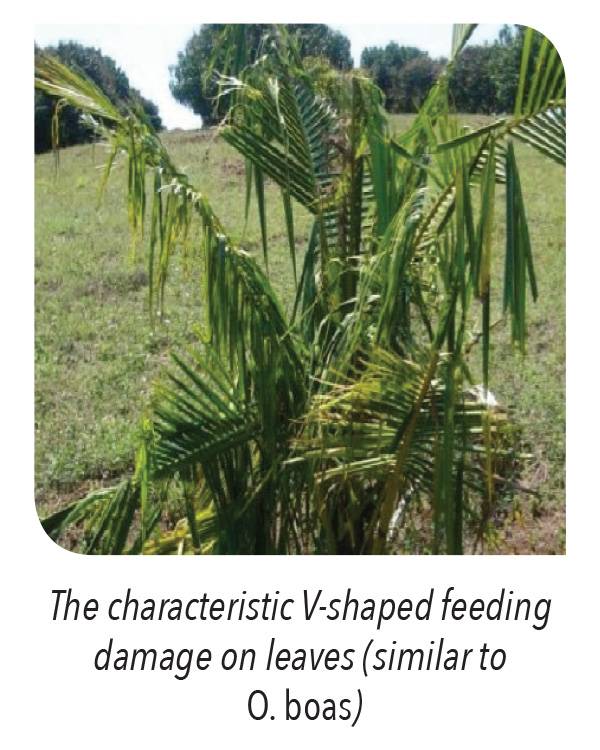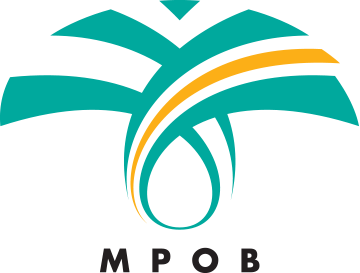General Information
Damage is usually effected by feeding adults. The adult beetles bore through stem bases of frond into the heart of the palms to feed on the vegetative bud and young leaves. The damaged young leaves eventually grows out and exhibits V-shaped notches on fronds. Severely attacked palms with damaged hearts will die; leafless though can remain standing.

Feeding damage may reduce fruit production, kill both seedlings and young and old palms, and discourage replanting. The beetle burrow at a rate of 4.2 cm/day, and will remain for 9 days inside its tunnel. The central spear cluster grows about 4 cm/day during the wet season and counterbalances the damage. In the dry season, spear growth is much slower and the palms are at this time more susceptible to damage. Boring holes also provides entry points for lethal secondary attacks and/or infection by the palm weevil Rhynchophorus (where present) or pathogens. In Ivory Coast (Africa), the adults of O. boas (and also O. monoceros) have been reported to be carriers of the nematode Thelastoma pterygoton.
O. monoceros breeds in manure heaps, decomposing vegetation/logs, and in dead standing coconut and oil palms. The larvae and pupae have been found in soil. Population peaks during dry seasons and diminish in the wet season. All stages are present throughout the year, resulting in overlapping generations.
It has recorded feeding on other economically important commercial crops such as coconuts, sugarcane, date palms, raffia palms, sisal hemp plants.
Distribution
Central and Southern Africa (tropical regions) including Madagascar, Mauritius and the Seychelles
Detection and Inspection
ADULT
Large, shiny, reddish-brown to black in colour. Approximately 3.5-4.5 cm long. The males have large rhinoceros type frontal horn. Nocturnal insects and feed during nighttime. Strong fliers.
Average lifespan is 5 months. Females lay about 25 eggs.
PUPAE
Fat and brown in colour measuring 4 cm long. Occurs in rotting plant debris with the larvae. Pupal period is about 3 weeks. Upon emerging from the pupal cases, the adults tunnel their way out of the breeding sites into the open.
LARVAE
Soft white, wrinkled grubs measuring 6 cm in length. Usually found curled up in a C-shaped position in the moist, decaying plant matter that the larvae feed on. Larval development duration is about months with three larval instars.
EGGS
Laid singly in manure heaps or decaying plant matter. Oval, dirty white and measure about 3.5-4 mm long. The larvae hatch after 11 days.

Prevention and Control
PHYTOSANITARY
Eggs are difficult to detect via visual inspection. Only the larger larvae beetles may be detected. Source germplasm from pest free areas, and ensure sanitation from sourcing to shipping. The import of germplasm material (seeds, pollen, tissue culture) must be accompanied by an import permit issued by or on behalf of the Director-General of Agriculture for Peninsular Malaysia (including Labuan), or the Director of Agriculture for Sabah, and a phytosanitary certificate issued by an authorised official from the country of export. The import conditions are available upon request from the Plant Biosecurity Division Malaysia. All consignments are subjected to inspection by the Agricultural Department prior to clearance by Customs. Germplasm material imported from high risk areas should be sent for third country quarantine before arrival onto Malaysian shores. The import of alternative host plant parts e.g. Phoenix dactylifera from infested areas should be enquired with DOA.
CULTURAL CONTROL AND SANITARY METHODS
A single beetle is capable of flying long distances and attacking many palms during its lifespan. Cultural control is the most feasible method. The recommended methods includes planting palms at the same time, at a close regular spacing so that a continuous canopy of foliage develops (isolated palms and palms of irregular height are more susceptible to attacks); cutting down and destroying dead palms; and remove plant debris and manure at the base of the palms. Other methods involve pheromone trapping, physical removal of adults and killing the beetles in the bore holes with a pointed wire.
Further reading
- Bedford, G O (1980). Biology, Ecology, and Control of Palm Rhinoceros Beetles. Ann. Rev. Entomol. 25: 309- 339.
- Ukeh, D A; Usua, E J and Umoetok, S B A (2003). Notes on the biology of Oryctes monoceros (Oliv.): A pest of palms in Nigeria. Global J. Agric. Sc., 2(1): 33-36.
- Hill, S D (2008). Pests of Crops in Warmer Climates and Their Control. Springer: UK. p. 270 and 272.
- Plantwise (2015). Coconut beetle (Oryctes monoceros). Url: http://www.plantwise.org/KnowledgeBank/ Datasheet.aspx?dsid=37973.

